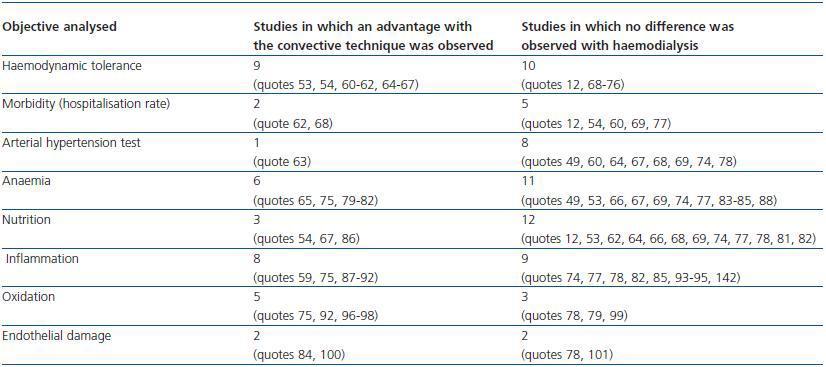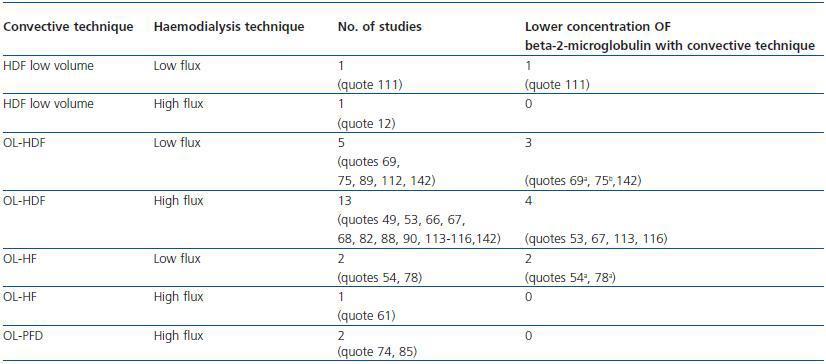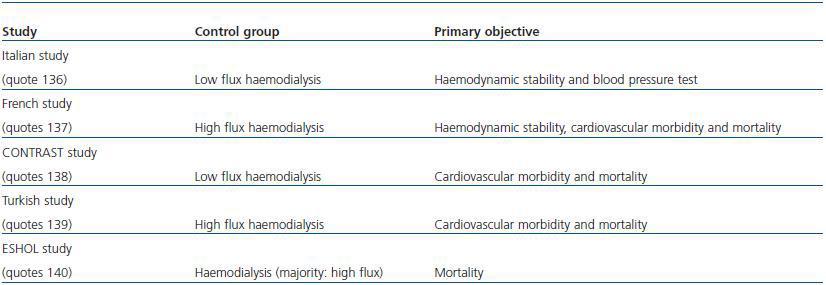INTRODUCTION
In the history of haemodialysis there are examples of technical advances that replaced existing procedures. Volumetric ultrafiltration control, the use of bicarbonate in dialysis fluid and synthetic membranes gave rise to the abandonment of pressure gradient ultrafiltration systems, acetate baths and cellulose membranes. The criteria that justified the changes were not always the same: the technical innovations in the first two cases were not established due to scientific evidence provided by research, but because clinical experience confirmed that ultrafiltration provided more accurate volumetric control and the bicarbonate bath allowed greater tolerance to the dialysis session. On the other hand, the gradual abandonment of cellulose membranes was a consequence of the research which demonstrated that synthetic membranes brought about a less significant inflammatory reaction and had a positive effect on the incidence and severity of amyloidosis due to beta-2-microglobulin amyloid deposit. We are currently experiencing a boom in dialysis techniques in which the convection principle is dominant over diffusion. The debate that has arisen is whether the time has come to replace traditional haemodialysis with convective procedures.
The use of convection instead of diffusion as the main mechanism of renal clearance is not currently being proposed. The pure convective technique (haemofiltration) is a procedure as long-standing as haemodialysis. Subsequently, various different convective techniques emerged (haemodiafiltration, biofiltration, PFD, AFB). None of these managed to represent a true alternative to conventional treatment, due to their complexity, greater cost and a lack of results that demonstrated a clear clinical advantage. The production of a sterile dialysis fluid (ultrapure fluid) which could be used as intravenous replacement fluid in convective techniques (¿on-line¿ convection) was the great technical advance which resolved, in part, the previous disadvantages and renewed interest in these procedures. ¿On-line¿ convection allows large ultrafiltration volumes to be obtained via simple methods and at a significantly lower cost.
Of the various convective techniques which included dialysis bath infusion, ¿on-line¿ haemodiafiltration has acquired a greater relevance due to both its gradual expansion and the number of scientific publications to which it has given rise. Recent general reviews and editorial commentaries confirm that ¿on-line¿ haemodiafiltration is a safe technique, which provides increased clearance efficacy and improved clinical results at a cost not much higher than haemodialysis.1-9
A recent survey carried out among dialysis professionals indicates that according to European nephrologists, ¿on-line¿ haemodiafiltration is the best dialysis procedure currently in existence.10
On the basis of data obtained from published studies, is there sufficient criteria to propose the replacement of haemodialysis by convective techniques, particularly by ¿online¿ haemodiafiltration as the most representative form?
METHODOLOGICAL PROBLEMS IN COMPARATIVE STUDIES
Many of the studies relating to convective techniques have methodological aspects which must be borne in mind when evaluating the results.
¿On-line¿ convective techniques use a high flux biocompatible membrane and an ultrapure dialysis bath. The biocompatibility and permeability of the membrane have a determining influence on the plasma concentration of beta-2-microglobulin,11-16 on the triggering of inflammatory phenomena induced by dialysis15,17-20 and on the onset of clinical complications due to amyloidosis of the patient under dialysis.21-27 Their possible beneficial effects on anaemia, nutrition and mortality are under debate.12,14,15,25,28-34
The ultrapure dialysis bath has been related with favourable/beneficial effects on anaemia35-41 nutrition,35,40,42,43 inflammation,36,38-42,44,45 oxidative stress,45,46 reduction in the levels of beta-2-microglobulin,38,43,45 prevalence of amyloidosis related with dialysis,26,47,48 and cardiovascular morbidity.44 Many of these beneficial effects are described in patients treated with convective techniques and it is difficult to determine if they should be attributed to the quality of the membrane, the purity of the dialysis bath or convection itself. In order to be able to evaluate the influence of convection, the haemodialysis technique with which it is being compared should be carried out in identical conditions of quality of bath and membrane. Indeed, an equal surface area of the dialysis machine, arterial flow and dialysis bath fluid flow are also necessary.
Another aspect that must be borne in mind is the lack of a control group in many observational studies, especially those which analyse the data before and after the change of technique. The improvement of results due to the ¿test effect¿ is a bias which must be borne in mind in this type of study. There are two examples showing the importance of the control group: Locatelli¿s study on membrane permeability and anaemia14 and Ward¿s study on haemodiafiltration and serum beta 2-microglobulin concentration.49 The conclusions of both studies would have been completely different if a control group had not been used.
Finally, it must be stressed that the results of nonrandomised studies must be analysed with caution. The convective technique, especially in postdilution form, requires an adequate blood flow, which conditions the selection criteria for patients. The fact that it is an alternative to the usual treatment means that this procedure is not usually used on patients for whom a poor prognosis is expected in the short term. This is particularly the case for the initial periods during which health care professionals are attempting to acquire experience with this technique. The selection bias, determined by vascular access and expected prognosis is inherent to any non-randomised study.
Despite all of the aforementioned limitations, can we be certain that the clinical results obtained with ¿on-line¿ convective techniques are clearly superior to those achieved with haemodialysis, based on existing publications?
RESULTS OF STUDIES ON CONVECTION
Systematic reviews
Two systematic reviews that analyse this subject have been published. The review by Rabindranath et al only includes randomised, controlled studies; initially, 18 studies with 588 patients50 were analysed; this was subsequently extended to 20 studies with 657 patients.51 The review by Varela and Ruano includes, in addition, observational cohort studies, but excludes all studies with less than 20 patients; the paragraph relating to convective techniques is an analysis of the data of 17 studies, seven of which are also included in the review by Rabindranath et al, with a total of 1,489 patients.52 The authors of both systematic reviews conclude that it is not possible to demonstrate that the convective techniques provide advantages in relevant clinical aspects such as mortality, morbidity, tolerance to dialysis or quality of life. They also highlight the methodological shortcomings of many studies and the need to undertake higher quality clinical tests, in order to reach definitive conclusions.
We shall summarise below the most significant data, including subsequent publications and aspects that have not been considered in the two previous systematic reviews.
Mortality
Two new randomised, controlled clinical tests analyse mortality. In the first test, no difference was observed between ¿on-line¿ haemodiafiltration and high-flux haemodialysis.53 The second test confirms a higher survival rate in the group treated with ¿on-line¿ haemofiltration with regard to the group treated with lowflux haemodialysis;54 both the authors themselves and the corresponding editorial commentary55 recognise the limitations of the study due to the small number of patients and the high abandonment rate.
The influence of the convective technique on mortality has been the subject of analysis in four observational studies undertaken using various patient records.56-59 While in the first test there were no statistically significant differences, in the other three studies, mortality was lower in the group treated with ¿on-line¿ haemodiafiltration. The data on mortality of these non-randomised observational studies must be analysed with caution due to the aforementioned selection bias.
Results of the clinical and analytical data
The conclusions of 47 comparative studies are shown in Table 1. On analysis of the characteristics of the haemodialysis technique, it must be emphasised that in 21 studies, the membrane was low flux; in 17 the dialysis machine had a lower surface area; in eight the arterial flow was lower and in 19 the dialysis bath was not ultrapure. Only in 12 studies these four parameters were similar with both techniques. Sixteen of these studies corresponded to observational studies in which the effects of the change in technique were analysed, without a control group. Despite these methodological limitations which represent a bias in favour of convective techniques, the results did not demonstrate a clear advantage over haemodialysis in the majority of the analysed parameters.
Initial studies presented a higher haemodynamic tolerance; it was subsequently demonstrated that it was due to a greater loss of heat induced by convection; no differences were observed when compared with cold haemodialysis or with temperature biocontrol.70-72,76
Further data in favour of convection is found in studies relating to the behaviour of various markers of inflammation and oxidation, whose clinical significance is still to be determined.
Dialysis efficacy
Convective techniques do not provide a relevant increase in the elimination of small molecules with regard to haemodialysis, provided that the rest of the variables which play a part in their clearance remain constant.102,103 Convection is more effective in the elimination of medium and large molecules. Its higher clearance capacity, reflected in the clearance rates or reduction of plasma concentration following treatment, has been shown with numerous molecules,49,69,103-107 but is not always accompanied by a reduction in the blood concentrations.
The most studied molecule is beta-2-microglobulin. Recent publications have shown a relationship between its plasma concentration and mortality.108-110 The results of 24 studies allowing the analysis of beta-2-microglobulin concentration with different convective techniques are shown in Table 2. It can be confirmed that in the majority of studies there are no differences with haemodialysis carried out with a high flux membrane.
Safety
The safety of convective techniques seems to be confirmed by the lack of studies that describe worse clinical results with these techniques. However, there are some aspects to be borne in mind.
The loss of proteins and amino acids is greater.118-121 The data of 23 studies in which the development of the plasma concentration of albumin following the start of convective treatment may be observed, is shown in Table 3. The general trend is a slight reduction in the concentration of albumin.
There is some uncertainty regarding the safety of the technique and its consequences in the long term due to direct infusion of the dialysis bath fluid into the bloodstream. Ultrapure water contains a wide variety of trace elements125 which, once infused into the blood, bind to plasma proteins and are difficult to eliminate. The possible effect of its progressive accumulation remains to be established. 126,127 Furthermore, it is essential to guarantee the sterility of the infused solution. The contamination of the endotoxin filter or, subsequently, of the hydraulic circuit would result in the infusion of a non-sterile bath fluid until the filter was changed or the regular endotoxin tests were carried out. In addition, it must be borne in mind that the dialysis bath fluid may contain other products of bacterial contamination which are not detected with the endotoxin tests,128,129 which pass through the protection filters130,131 and which are capable of inducing and maintaining the in vitro inflammatory response.130,132 This bacterial residue is transferred directly into the bloodstream during ¿on-line¿ convective techniques, although until now it has not been confirmed that they are capable of causing an in vivo inflammatory response.
It is possible that haemodialysis with high flux dialysis machines involves a phenomenon of retrofiltration and that both the trace elements in the dialysis bath and the possible bacterial residue may reach the blood compartment. However, it must be borne in mind that the coating of the dialysis machine membrane by blood proteins represents a limit to the transfer of contaminating products from the dialysis bath through the dialysis machine.133-135
CLINICAL CASES IN PROGRESS
In order to clarify some of these matters, five randomised, controlled clinical tests are being carried out, which compare the results of ¿on-line¿ haemodiafiltration with conventional haemodialysis (Table 4). It is noteworthy that in two of the studies the membrane used in conventional haemodialysis is of low permeability. The results of these studies will help clarify aspects currently under debate. At present, only the recently published data of one of the studies is known (the CONTRAST Study): ¿on-line¿ haemodiafiltration brings about a more intense and prolonged platelet activation than haemodialysis; the clinical significance of this discovery is still to be established.141
CONCLUSIONS
We can conclude that the dialysis techniques based on convection are procedures with interesting aspects, but, until now, its clear clinical superiority over haemodialysis with a high-permeability biocompatible membrane and ultrapure fluid has not been demonstrated. Its safety is guaranteed by the lack of publications which show worse results, although there are some issues which remain to be clarified. Until the results of the clinical tests that are currently underway are published, convective techniques will have to be used according to individual experience or if its use is desired, and the facilities of each centre. The time for change has not yet come.
Table 1. Comparative studies between convective techniques and haemodialysis
Table 2. Influence of the convective technique on the plasma concentration of beta-2-microglobulin
Table 3. Development of the concentration of albumin following the initiation of convective treatment
Table 4. Clinical tests with ¿on-line¿ haemodiafiltration in progress














